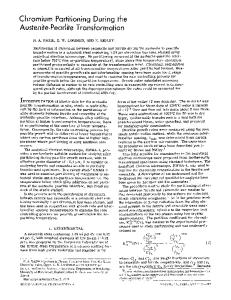Comparative Study on Austenite Decomposition and Cu Precipitation During Continuous Cooling Transformation
- PDF / 944,848 Bytes
- 9 Pages / 593.972 x 792 pts Page_size
- 48 Downloads / 338 Views
INTRODUCTION
THE preferred properties of Cu-bearing highstrength low-alloy (HSLA) steel such as high strength, excellent ductility, and good weldability are usually obtained through careful design of microstructural evolution with appropriate heat-treatment or manufacturing procedures.[1–4] The microstructure depends on the initial alloy composition, thermomechanical processing parameters, and the degree of cooling, which all have important effects on the kinetics of austenite decomposition and consequently on the ultimate microstructures.[5–10] Depending on the actual cooling rate and the extent of solute enrichment, the transformation of austenite can change from diffusional to displacive model, leading to the formation of a variety of structural constituents including ferrite, bainite, martensite, and retained austenite (RA).[11,12] Correlated with the austenite-to-ferrite transformation, the precipitation reaction of Cu phases is equally technologically important and of fundamental scientific interest.[13] Different from the dislocation-interacted isothermal precipitation during the aging of martensite, the nonisothermal precipitation during the continuous QING-DONG LIU, Doctoral Student, and SHI-JIN ZHAO, Professor, are with the Key Laboratory of Microstructures and Institute of Materials Science, Shanghai University, Shanghai 200072, P.R. China. Contact e-mail: [email protected] Manuscript submitted April 26, 2012. METALLURGICAL AND MATERIALS TRANSACTIONS A
cooling of austenite is usually described in terms of interphase precipitation.[14–16] However, an aging reaction can also occur during cooling, i.e., an auto-aging phenomenon after the austenite decomposition.[17,18] The nature of the precipitation reaction and the final morphologic distribution of Cu phases may be significantly influenced by the ratio of the austenite/ferrite boundary migration rate to the copper precipitate growth rate, and the actual copper concentration in the solute-depleted ferritic phases after the cessation of the austenite-to-ferrite transformation.[19] In HSLA steel with a given composition, the austenite-to-ferrite transformation kinetics shows that Cu interphase precipitation occurs only at a certain region of critical cooling rates and temperatures.[5] The nucleation and growth of Cu precipitates can be constrained at a high cooling rate such as during quenching, or at a slightly lower cooling rate associated with the formation of bainite and martensite because the displacive transformation allows little time for the diffusion of Cu atoms. The interphase precipitation of Cu phases is considered to not occur in association with the intermediate transformation products such as granular ferrite and acicular ferrite (AF).[13] However, numerous nanometer-sized Cu clusters are detected at atomic scale by atom probe tomography located wholly within crystals of these phases.[20] Thus, the auto-aging precipitation may be an alternative explanation for the appearance of Cu clusters. The formation of Cu precipitates on a migrating austen
Data Loading...











